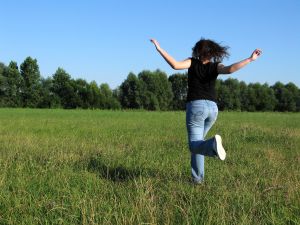Funny story: one day I was out for a run on the rail trail with my brother, and we encountered a pedestrian walking a dog off-leash. I am somewhat knowledgeable about dogs, having worked at a vet clinic in my youth, however this was not a breed I recognized. It was a tiny, white puffball of some kind. Anyway, the dog saw us, and predictably, gave chase while the owner screeched “get back here!” I stopped running, and the dog stopped and looked at me; the owner came and got it, and we continued on. Quite a few seconds later, we heard the owner screeching again from a long way back, just before the dog was hanging on to the back of my brother’s ankle. I knew enough to stop again, and this time I added a stern “No!” but my brother, who is so skinny I can see why he would be mistaken for a stick, was hopping around trying to avoid the dog.
Yes, the image of my 6′ 4″ brother hopping around with the puffball will forever make me chuckle; but the principle behind it isn’t so funny. This dog was off leash in a leashed area, and clearly outside of the owner’s control.
As much as I like dogs, I hate it when I am running along, and someone’s dog comes bounding towards me, while the owner is yelling “don’t worry, he won’t hurt you!” Well quite frankly, I don’t really care that he won’t hurt me; I just don’t particularly want to pet him (I need those hands hair and slobber free to wipe sweat out of my eyes!), trip over him, or have to stop running so the owner can regain control. If I am running in a leash free area, that is my stupid fault; but if not, I don’t want to be harassed by a dog.
Even worse is when I am running on a country road and a dog comes tearing off its property after me. Once I can recall that happening when a car was coming and I was on the opposite side of the road. Fortunately the owner was outside and I was able to get their attention to call the dog back before it got into the path of the car, but not before I felt thoroughly sick with panic.
Almost every runner I know can recall a story of being chased by a dog. It can be inconvenient, or downright terrifying. There are a number of reasons why dogs like to chase runners, be it playfulness, protectiveness, or just the compulsion to chase moving objects.
If you are being chased by a dog, the best thing to do is stop, stand at a 90 degree angle to the dog, and shout “NO!” at it. Most times the dog will lose interest when it realizes that you are human and not interested in being chased. Then you can back away so you can keep an eye on it; do not start running again until you are sure the dog is either back in the control of its owner, or is no longer in sight.
If the dog attacks and bites, you are well within your rights to protect yourself. If you can get your knee up as it is jumping at you, you can catch it in the chest and knock the wind out of it, which might make it think twice. If it is determined to get a piece of you, however, a sharp kick to the chin should cause the most amount of pain with the least amount of damage. When it is over, by all means feel free to take appropriate legal action; after all, if letting a dog attack people is a habit for the owner, you could be doing a public service. If you are a dog owner having trouble with your dog’s compulsion to chase, this is a great reference article that might help you.
And a video on the subject…
httpv://www.youtube.com/watch?v=LU2-scHsucM











 As the weeks went by and I gradually added more minutes of running and reduced the minutes walking, I would make it farther and farther around the block. Then one day, I made it all the way around, and I wasn’t finished yet.
As the weeks went by and I gradually added more minutes of running and reduced the minutes walking, I would make it farther and farther around the block. Then one day, I made it all the way around, and I wasn’t finished yet. Our Magazine
Our Magazine
